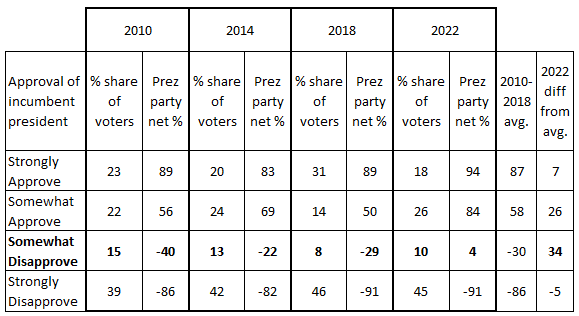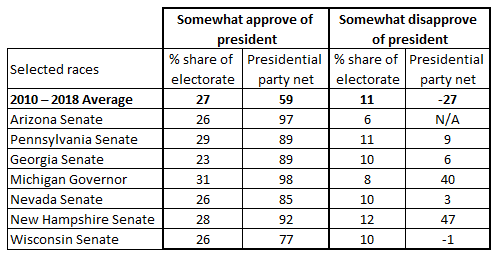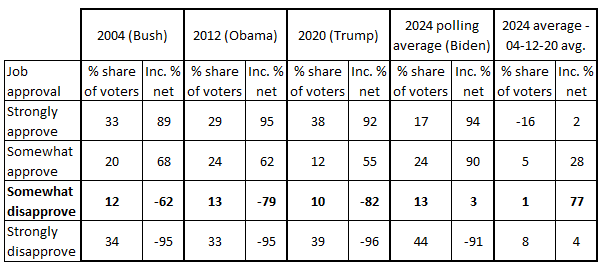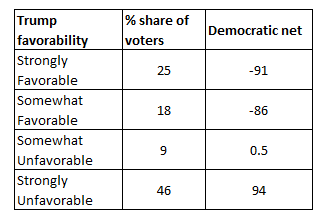| Dear Readers: With the first debate scheduled for this evening, we thought it was a good time to look at a potentially decisive group of voters that both candidates should be trying to woo: Those who only “somewhat” disapprove of Joe Biden’s job performance. As veteran poll watcher Dan Guild explains in today’s Crystal Ball, typically those who disapprove of the president’s job performance vote against him (or his party). But as we saw in the 2022 midterm, and currently see in 2024 polling, Biden and Democrats are competitive among those who somewhat disapprove of the president—giving Biden a path to victory despite a weak overall approval rating. How each candidate attracts—or, perhaps more importantly, repels—these voters could go a long way toward deciding this election.
— The Editors |
KEY POINTS FROM THIS ARTICLE
— Despite an overall job approval rating hovering around just 40% in polling averages, President Biden retains a path to victory.
— This is because of his unusual competitiveness among voters who just “somewhat” disapprove of his job performance, a group among whom Democrats performed relatively strongly in the 2022 midterm and where polling shows Biden holding up reasonably well in 2024.
— Relatively similar numbers of voters strongly disapprove of Biden’s job performance and hold a strongly unfavorable view of Donald Trump. Biden’s “strong” approval is fairly low, though, compared to recent incumbents who ran for reelection.
— The “somewhat disapprovers” skew younger and nonwhite, which presents Biden with both an opportunity and a challenge.
“Somewhat” disapprovers could decide 2024
You could say modern politics is defined by the presidential election of 2016, when a significant number of voters held an unfavorable view of both major party candidates. The 2016 election is the first election since at least World War II in which both candidates were unpopular. According to the 2016 exit poll, Hillary Clinton had a 55% unfavorable rating and Donald Trump had a 60% unfavorable rating.
Why did Trump win the 2016 presidential election? Because he won 47% to 30% among the 18% who had an unfavorable opinion of both Clinton and Trump. In 2020, the size of this group fell dramatically. In the 2020 exit poll, only 3% of the electorate said they had an unfavorable opinion of both Joe Biden and Trump. This group is sometimes called the “double haters,” but the term is actually misleading. Many in this group do not hate both candidates, but in fact only somewhat dislike one of the two candidates. In any event, Biden leads among this group 47% to 42% in recent polling.
The election of 2022 was the election of the “somewhats,” and 2024 may be as well. These are voters who say they somewhat disapprove of Biden’s job performance. Approval is often reported as just whether a respondent approves or disapproves of the president’s performance. But some polls will report it as strongly approve, somewhat approve, somewhat disapprove, and strongly disapprove.
Here’s why 2022 was the election of the somewhats. Table 1 below compares the national House exit polls for the last 4 midterm elections. Among the 10% of the electorate that somewhat disapproved of Biden’s job performance, the Democrats won by 4 percentage points, 49% to 45%. This was unprecedented compared to recent midterms. The best performance in a recent midterm among voters who somewhat disapproved of their president’s job performance was losing them by 22%. Moreover, the Democrats did substantially better among those who somewhat approved of Biden’s job performance than the incumbent presidential party had done in the 2010, 2014, and 2018 midterms.
Table 1: Recent incumbent party midterm results by presidential approval

Source: Exit polls
The ability of Democrats to appeal to those who somewhat approved or somewhat disapproved of the president’s performance was critical in key Senate races. These numbers are astonishing. From a historical perspective, the Democrats arguably should have lost every one of these races, but as it was, they lost only one of them on the list below (the Wisconsin Senate race). Note in Table 2 how Democrats did much better with these kinds of voters than the president’s party typically did in recent midterms.
Table 2: Presidential party performance in selected midterm races

Note: 2022 Georgia Senate exit poll is for first round of voting, not the later runoff
Source: Exit polls
The somewhats and 2024
In 2020, I wrote about state polling, job approval, and presidential reelection. But if the Democratic success in ’22 continues in ‘24 among those who somewhat disapprove of the president, Biden is likely to run well ahead of his job approval rating against Trump.
Table 3 below compares Biden’s current polling against the exit poll data from 3 prior elections that featured incumbent presidents running for reelection: 2004 (George W. Bush), 2012 (Barack Obama), and 2020 (Donald Trump).
Table 3: Biden polling vs. recent incumbent performance by approval rating

Some key takeaways from Table 3:
— Biden’s strongly approve number is substantially below the average for incumbent presidents. Only 17% strongly approve of Biden—on average 33% strongly approved of the past 3 incumbent presidents who were running for a second term. The lack of enthusiastic support may make turnout problematic for Biden.
— However, Biden’s performance among those who somewhat approve of his performance or somewhat disapprove of his performance is simply astonishing. Biden runs 28 points ahead of the recent average among those who somewhat approve of his job performance compared to the average, and 77 points ahead of the historic average margin among those who somewhat disapprove of his job performance.
Of course, the reason for this is that his opponent is Donald Trump.
Table 4 shows Donald Trump’s favorable rating and his share of the respective vote in each category. Notice that just like the somewhat Biden disapprovers are a swing group, so too are those who are somewhat unfavorable toward Trump.
Table 4: Trump performance by favorability in national polls

Source: This average is based on polling from YouGov, Echelon Insights, Fox News, NBC News, and Siena College/New York Times.
Trump and Biden are mirror images of each other. In my averages, 44% strongly disapprove of Biden’s job performance. Trump beats Biden by 91% with that group. Meanwhile, 46% of the electorate has a strongly unfavorable opinion of Trump. Biden beats Trump by 94% with that group.
Who are the somewhats?
Table 5 shows the percentage of respondents who somewhat disapprove of Biden’s job performance (13% on average in recent polls), along with some selected subgroups. This represents an average of 8 different national pollsters who conducted polls over the past several months. Some of the pollsters polled just once (CNN and the Pew Research Center), while others, like YouGov, polled multiple times. For those who polled more than once, I averaged their polls to produce a single number—in other words, the average itself includes each pollster just once. The list of national pollsters included is listed in the note below Table 5. I did this to try to show some subgroups who were more likely to have a higher share of somewhat disapprovers.
Table 5: Makeup of Biden somewhat disapprovers

Source: National polls included are from CNN, Fox News, Marist College, Marquette University Law School, Pew Research Center, Quinnipiac University, New York Times/Siena College, and YouGov
The first number that leaps out from Table 5 is the number for those between 18-29. About 25% of those under 30 somewhat disapprove of President Biden’s job performance. I track this 18-29 vote, and there is a lot of divergence among pollsters on how Biden is performing among this group against Trump. The 2020 voter analysis from the Democratic firm Catalist, which I think is the best available although the numbers from other analyses/exit polls are similar, found that President Biden won among those under 30 by 60%-37%. That so many in that group say they somewhat disapprove of the president’s job performance is a very real challenge for the president.
Two other groups worth noting here are Black and Hispanic voters: Each group has a higher-than-average share of somewhat disapprovers. Much has been written lately about shifts in both groups towards Donald Trump. I am very skeptical of those shifts and have written about that here. Nonetheless, even if the shifts do not materialize, turnout may also pose a very real challenge for the president.
Meanwhile, note that the number of somewhat disapprovers is higher among independents than Democrats or Republicans. It makes some sense, intuitively, that independents would be more likely to express this ambivalent viewpoint on the president.
As noted earlier, 2016 was an election defined by voters who disliked both major party nominees, and there will be a considerable share of those kinds of voters in 2024. But 2022 was an election of the “somewhats,” and 2024 may be as well. How well Biden can hold on to the people who judge him somewhat but not strongly harshly is a key factor in this election.
| Dan Guild is a lawyer, former prosecutor, and project manager, and he is a past Crystal Ball contributor. He has written for CNN and contributed data to the Washington Post’s 2020 primary prediction tool. He writes on a regular basis at Bleeding Heartland. |
